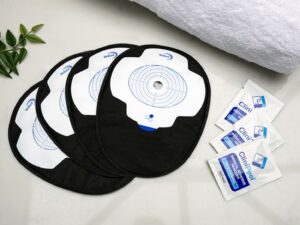Our guides and resources provide information and education to help patients succeed before and after surgery. We also provide educational support to healthcare professionals to develop clinical knowledge.
Filter
Article
How to Use the Appeel Sterile Range – A Step‑by‑Step Guide
This page brings together clear, concise video demonstrations showing how to use each format in the Appeel Sterile range; sachet, foam applicator, wipes and spray – to help support best practice in clinical care.
Clinical Case Study
Breaking Free From Overactive Bladder
This case study explores the real-life experiences of five patients who successfully used Tensi+ to manage overactive bladder (OAB) symptoms. Their stories illustrate how this non-invasive, self-administered therapy, designed for use at home, helped reduce urgency and frequency, improve sleep, and restore confidence and independence.
Article
Navigating Intimacy with a Stoma
From practical steps to embracing new ways of thinking, Dr Zainab Noor discusses psychological strategies to help you approach intimacy with confidence.
Guide
Emotional Wellbeing Guide For People With a Stoma
This guide explores practical tools and strategies to help you take care of your emotional wellbeing while living with a stoma. Written by Caroline Rudoni, a Stoma Care Nurse and Dr Zainab Noor, a Clinical Psychologist.
Article
Managing Sleep Disruptions After Stoma Surgery
This article written by Dr Zainab Noor explores why sleep can feel so fragile after stoma surgery and offer psychological ways to ease the fear of your stoma bag leaking, rebuild a sense of safety, and support your body’s return to rest.
Article
Learning to See Yourself Again: Body Image After Stoma Surgery
This article written by Dr Zainab Noor explores how stoma surgery can affect how people feel about their bodies. It looks at how the ways we try to protect ourselves can sometimes make us feel even more distant from our bodies and shares simple, practical steps to help rebuild a sense of connection and comfort over time.
Article
Overcoming Social Avoidance After Stoma Surgery
This article written by Dr Zainab Noor describes some of the possible experiences related to pulling away from social life related to the challenges of living with an ostomy, and how small habits meant to protect you can keep you isolated.
E-Learning
HCP
The Importance of Continence Care
This CPD-accredited course explores the role of fixation devices, also including urinary sheaths within continence care, focusing on how they enhance patient comfort and ensure stability, including the secure attachment of drainage bags.
Article
HCP
Maintaining Skin Integrity in Diabetic Foot Ulcer Care: The Role of Appeel® Sterile
Three case studies, conducted by podiatrists, demonstrate how the Appeel Sterile Spray supports atraumatic dressing removal, especially for patients with fragile skin often seen with diabetes and peripheral arterial disease.
Clinical Case Study
HCP
Improving Sleep and Safety With a Urinary Sheath
This case study, written by Community Specialist Nurse Anna Moseley, explores the use of the CliniSure urinary sheath system in a patient with Parkinson’s disease and multiple comorbidities, highlighting how a tailored continence solution helped reduce fall risk, improve sleep, and restore quality of life for both patient and caregiver.
E-Learning
HCP
Supporting Stoma Patients’ Sexual Wellbeing
Designed for Stoma Care Nurses and healthcare professionals who support patients with a stoma. This CPD-accredited course provides insights and advice about supporting stoma patients with their sexual wellbeing.
Guide
Understanding Catheterisation
An easy to understand guide to urinary catheterisation including what to expect from the procedure and how to maintain your catheter afterwards.



